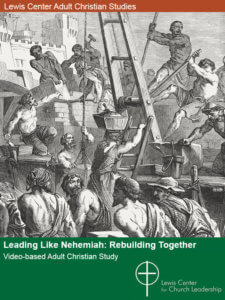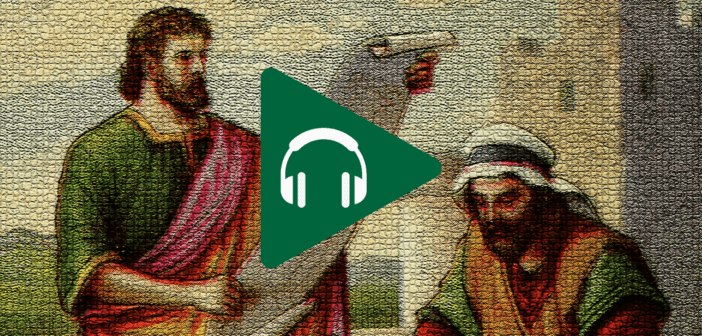
How does the story of Nehemiah guide leaders today? Lovett H. Weems Jr. explains why Nehemiah is so relevant to leaders in today’s church and how the book of Nehemiah informs our understanding of a leader’s calling and tasks.
Listen on Apple Podcasts | YouTube Music | Spotify
Read in-depth interview
- Transcript
-
Announcer: Leading Ideas Talks is brought to you by the Lewis Center for Church Leadership of Wesley Theological Seminary in Washington, DC. Subscribe free to our weekly newsletter, Leading Ideas, at churchleadership.com/leadingideas.
Leading Ideas Talks is also brought to you by Leading Like Nehemiah: Rebuilding Together. This six-session video-based study curriculum lifts up key themes in Nehemiah’s witness that can inspire and guide faith leaders today. Regularly $49, this study is just $25 through August 31. Learn more, watch an introductory video, and view sample Study and Discussion Guide pages now at churchleadership.com/nehemiah.
How does the story of Nehemiah guide leaders today? In this Leading Ideas Talks episode, Lovett H. Weems Jr. explains why Nehemiah is so relevant to leaders in today’s church and how the book of Nehemiah informs our understanding of a leader’s calling and tasks.
Doug Powe: Welcome to Leading Ideas Talks, a podcast featuring thought leaders and innovative practitioners. I am Douglas Powe, director of the Lewis Center and your host for this talk. Joining me is Dr. Lovett Weems, former director of the Lewis Center and current consultant for the Lewis Center. His latest book, co-authored with Ann Michel, is Generosity, Stewardship, and Abundance: A Transformational Guide to Church Finance. Today, however, our focus is on leadership and the book of Nehemiah. Glad to have you with us today.
Lovett Weems: Thank you.
Doug Powe: I want to start by asking, why do you think Nehemiah is so popular when it comes to leadership?
Lovett Weems: I think Nehemiah was someone that most of us can identify with. Here’s someone who wanted to do God’s will, a man of faith, a man of prayer. He also was someone who cares about the people in his world and what’s going on with them. And he wanted to help. He wanted to help advance God’s ways. He wanted to help advance the people with whom he worked. But yet, he didn’t know exactly how.
So much of what’s going on in the book of Nehemiah is seeing that struggle to know that God is calling me to do something but trying to discern what that is, and then, once that happens, following the various stages. And it’s more complicated than we often think. I think Nehemiah was simply someone that’s just very easy for us to identify with because all of us have faced situations where we know something is not right. We know something needs to be done. But, at that moment, we’re not sure that God may be calling us to do something as part of that solution.
Doug Powe: Lovett, I appreciate particularly where you ended: thinking about knowing something that needs to be done and that God is calling us to do something. We have an adult study, as you know, at the Lewis Center called Leading Like Nehemiah: Rebuilding Together, and you are featured in this study. In the study, you talk about discerning God’s vision. How does Nehemiah help us think about discerning God’s vision in our congregational setting? I think that sort of links to what you were just discussing.
Lovett Weems: Well, on the one hand, it appears at first glance very simple. It’s almost like the book Nehemiah is giving us a very simple playbook for how it happens. That is, in chapter 2:17-18, we find a simple four-part process that can be used in visioning. Now, what we have to keep in mind is that it’s easy to forget all that went on before that passage and certainly everything that went on after that. But for this passage of Nehemiah, discerning a vision is a part of what goes on. But enacting the vision is a very, very different thing.
So, let’s look at the four-part outline that he gives. First of all, Nehemiah helped to define reality. He simply said, “Look at the trouble we’re in. Look at the gates. Look at the wall. We’re in trouble.” So, he helped define reality. This did not come out of the blue. He had been hearing these stories from travelers going through for a long time. Also, when he had arrived to help the people, he and a few others one night went out on their own mission to take a look at the walls, and what they saw was devastating. So, when Nehemiah named this reality, he was not advancing his own agenda. Nehemiah was not someone who had spent his whole life wanting to rebuild a wall. He didn’t do walls. He had never been known for building walls. He was simply naming that reality because that’s the critical thing that they faced.
Now, for instance, if someone had said at that moment, “We disagree,” there would have been no need for an argument. “Let’s go again. And let’s get some more people to go with us, and if it turns out that the wall is in great shape and the gates are in great shape, fine, we don’t need to spend time, energy, and resources on rebuilding a wall. But, if not (and here comes the second part), come, let us rebuild the wall.” So, you have the articulation of what becomes their vision.
People ask, “But where does the vision come from? Does it come from the top or the bottom?” It doesn’t matter — if it’s the right one. Often a leader will name a vision not because they’re smarter or more spiritual but usually because they’ve been spending more time thinking about it, praying about it, have access to more information. But, in any case, it has to ring true. So, number one, help define reality. Then, number two, what are we going to do about it?
“Come let us rebuild the wall.” Heads began to nod. People confirmed. They said, “That makes sense to us. We’ve known that for a long time.” That’s the third point. And then the fourth point was that everyone made a commitment. Everyone committed themselves to the common good.
Today, that may be a governing body vote. It may be a capital campaign. But everyone commits themselves. So, we see a four-step process that seems simple. But in reality, it’s not so simple. But it is a wonderful outline for us to use.
Doug Powe: Lovett, let me follow up. And I love the way you laid that out, so nice and easy for our listeners to follow. But as you said, it’s not so simple. Let’s move to the congregational study and just pick the easy one: a congregation that’s looking to go out and do something in the community.
The pastor has this vision. The pastor feels a calling. And this may be a chance for you to talk about calling, also. In the congregation, you have some people who want to go with the pastor and others who don’t. So how do you navigate that? Because part of what you’re saying is that he’s defining reality, and it could be just as plain as day to the pastor that there’s a need for us to get out there. But others are sort of like, “Well, no. We like how it feels inside the church here.” So, at least in my opinion, that’s where it can become sort of challenging for people.
Lovett Weems: Absolutely. A vision not only has to be right in that it’s a good thing. It has to be right for us. It has to connect. If it doesn’t, it won’t succeed. That doesn’t mean it’s a bad idea. It just means the timing’s not right or the readiness is not there. If that’s the case, no matter who the leader is, it’s not going to succeed. It may be that you have to take a step back and find something that will connect.
Let’s think about it from the perspective of this leader who’s come up with this vision. They may see this as “what God is calling me to do.” Well, we all have a calling from God and, no matter where we are, we’re trying to live out that calling from God. And other people have callings as well. But God’s calling for a leader is not just their personal relationship with God. It also includes a calling from the context, that is, what’s going on with the people God has given us? What’s most urgent? What’s most on their minds? What’s most critical in the community we’re serving?
Then another part of that calling has to do with one’s position. As a pastor, one has a tremendous opportunity to set an agenda, to get almost anything talked about any time you want it to be talked about. But you do not have the power to make something happen. Even if you get a vote, it may not happen, so you’ve got to see not only what is my position, but what is my relationship to the people? How long have I been here? How much credibility do I have? How much standing? How much integrity do I have? And anyone who knows me knows my commitment to this cause.
And then usually it’s going to have to begin with listening, talking to some people. That’s what Nehemiah did. When people from home would be traveling through where he was working, he would ask them, “How are things at home?” They would say, “It’s not very good.” “What’s the problem?” “Well, just when we build up a little bit, our adversaries that surround us come in and tear down whatever we’ve started, and the spirits of people are very down at this time.” Nehemiah was listening, so he had a good understanding that this is not his agenda but it’s the right agenda for us to take that next faithful step.
Doug Powe: Lovett, you sort of covered this, but I just want to see if you have anything to add. You’ve talked about Nehemiah caring for the people, that a good leader cares for the people. And you’ve named how he did so and you connected that to what we need to do today. Is there anything else you would say that’s important in terms of caring for the people?
Lovett Weems: I’ve pointed out that he listened to the people. That’s a wonderful way to honor people. Leaders need to have the right questions and they need to be asking those all the time. But you’ll also notice that Nehemiah spent a great deal of time in prayer, praying both for the people and for God’s inspiration and guidance. Nehemiah was honest with the people. He was able to be a little more direct with the people because they knew him and because he believed that what he was saying would not be anything that would surprise them. And he helped the people take their next faithful step.
And that’s what we always want from a leader. We want them to treat us well. We want them to be people of integrity. But we also want them to help us deal with the greatest adaptive challenges we have at the moment.
Doug Powe: Thank you. And I think that does help sort of round it out and really points to the way Nehemiah cared for the people and helped the people have hope, which is critically important. I want to shift gears a little bit. As you know, Lovett, there are a lot of people, when they think of a leader, they get the picture of almost the old TV movies — of this person out there by themselves taking on all comers. But the reality (and in the Nehemiah text) is that he can’t do it alone. It requires others to participate in this work with him. Can you share how leaders go about building up a team to get the work done? And why is it important for leaders not to think of this “Lone Ranger” model as the way to go?
Lovett Weems: It’s easy for a leader to think that once you have gotten through the four steps that everyone has affirmed the vision, that everyone has made a commitment, that your role is more in the background. You’ve done your part. Well, you need to realize you’re only 10 or 20 percent toward accomplishing the vision once you get clarity.
It’s very hard to get to that first 10 or 20 percent, but you have to build a team. You need to ask, “Who are the people without whom this vision cannot become a reality?” That’s very democratic because it’s not based on the people, it’s based on the vision. If the vision is rebuilding the wall, there’s likely to be some people that are essential to that task who might not be as essential if it were a different type of vision. But you also have to be thinking of all the stakeholders. Who are all the groups whose cooperation is needed? They may not have the equipment needed for the wall. They might not have the technical expertise. But they are stakeholders, and their cooperation is needed. Several people have said that in organizations such as the church, usually no one person can say “yes” to something and make it happen. But almost any group of people can say “no” and cause it to stop even if it’s been approved. Nehemiah discovered very quickly that despite a unanimous vote, people started complaining and grumbling. “It’s too hot. It’s taking too long. It’s costing too much. Some people are not doing their fair share.” Nehemiah did not step back and say, “Look, we agreed to this.” No, he was not reactive, but he was responsive. For example, he discovered that if you assign people to work on the wall nearest where they live, they do better work and they don’t complain about it as much. He also found that there were things that could be done perhaps by people who couldn’t do other things: they could prepare food, they could bring water, they could do a lot of things. And then you have an entire chapter in Nehemiah that’s kind of like a bulletin insert in which it says, “We want to thank so-and-so for this. We want to thank so-and-so for that.” So, there was this realization not only that it takes a team, but you’ve got to support them and encourage them and keep up their spirits.
Doug Powe: You sort of headed down this path a little bit, but I’m going to come at it a little bit differently. You talked a little bit about how things can happen that may distract team members. As you know, whenever you are following a vision, trying to follow God’s calling, there are going to be adversaries. And of course, Nehemiah certainly had adversaries. What can you share in terms of the way Nehemiah dealt with the adversaries that might be helpful for us today?
Lovett Weems: Well, the people had been surrounded by adversaries for quite a while and the advantage was strictly with them because they had more force. The people were not very organized. When Nehemiah came, not only did he give them a vision of rebuilding the wall, but he organized the people in shifts. There were people who were guarding, people who were working, people who were sleeping. This created a problem for the adversaries, so what they did is to turn to what we would call dirty tricks. Now they were not going to do a frontal assault with weapons. No, they’re going to start rumors and gossip. So, we have this classic scene where Nehemiah himself was up working on the wall, and the adversaries sent a delegation and they say, “Nehemiah, if you don’t come down and stop this work, we’re going to start telling stories about you. We’re going to go to the king and say, ‘You know, Nehemiah got permission to be here to help these people. But he’s not helping. He is building up an army to come and overthrow you.’ That’s what we’re going to tell him about you.” So ,what was Nehemiah to do? Nehemiah didn’t say, “Oh, no. Don’t do that.” Nehemiah simply said, “I’m doing a great work. I cannot come down.” And so, he stayed with the task. He had taken account of the adversaries. But he stayed with the task.
Leaders face adversaries that may not have weapons and may not be necessarily an organized group. But Nehemiah stayed in that conversation, but he stayed connected to the vision as well. Leaders need to be as responsive as possible because there will be unforeseen problems. People’s lives will be disrupted. The space that has usually been used for something may have to be used for something else while this grand dream is being accomplished. So be responsive. Be respectful of adversaries. Stay connected. But keep your eye on the vision, as well.
Doug Powe: Just a quick follow up. For leaders in the church today, by analogy, how can they stay focused on what God is calling them to do, even in the midst of people not only threatening to spread rumors, but actually doing so? So, any insights on how you stay with the task and try to help others to stay with the task with all this stuff swirling around them?
Lovett Weems: Well, I think Nehemiah gave an example here of what might be called “taking the high road.” He neither necessarily negotiated nor capitulated. He’s simply took the high road. He named what we are about. And he stayed with that. Again, being responsive and particularly communicating the ultimate goal — this is something that Nehemiah was able to do.
What happens in any group is that, when that next faithful step is discerned, it’s going to be some specific thing. And most people only then will think about that specific thing. For example, with Nehemiah, it was about rebuilding the wall. But Nehemiah, had to remind them, “You know, we’re not in the wall building business. We’re in the God business, and this is about the preservation of our faith. This is about doing what God’s calling us to do, knowing that after the wall is rebuilt, God is going to have something else for us.”
In a congregation it may be beginning a new service. It may be building a new building. It may be something else. Everyone will want to talk about that specific thing. It’s just like during the historic Montgomery bus boycott that began the modern civil rights era. Yes, it was about a bus boycott. But Martin Luther King Jr. and other leaders had to remind the people, “Don’t think this is about a bus boycott only. That’s too small. This is about justice. This is part of our larger agenda for justice and equality.” So, whatever that next step is, leaders have to put it in a larger perspective. This is not about a new service. It’s about reaching people God has given us whom we’ve not been able to reach. It’s not about the new building. It’s about the children who will come to faith in that building. It’s about what God wanted from this church from day one.
Doug Powe: That was very helpful. I really appreciate talking about how you have to put it into the bigger picture to really help people to think about it. As we draw this to a close, I’ve talked about this study the Lewis Center has. I just wanted to give you a chance to talk about why you think this study would be good for church leaders to do in their congregations and how it may be helpful.
Lovett Weems: Well, I think there are a lot of things that we can learn from Nehemiah that would be very applicable to those who are leaders within a congregation. A leadership team might be a good place for this kind of study to be used because it helps us see that leadership and visioning may seem simple, but they are not. It will help us see that naming what needs to be done is not the same as accomplishing it, and that it takes a team of key players and stakeholders working together. There will be setbacks along the way. Everything looks like failure in the middle and, even when successful, there will always be another mountain, another vision. As Nelson Mandela said, it’s like climbing to the top of a great mountain. It’s hard to get there. But you finally make it, only just to discover there’s yet another mountain to climb. And so church leaders can help everyone in the congregation come to know that we’re on a journey with God. It did not start with us. It will not end with us. But God is calling us to help write this next chapter and then another chapter while knowing that, as Nehemiah says, “Without God, there is nothing. And with the help of God, we accomplished this.”
Doug Powe: Lovett, this was fantastic! Thank you for being with us today and sharing those wonderful insights related to Nehemiah.
Lovett Weems: Thank you very much.
Announcer: On the next Leading Ideas Talks, Jessica Anschutz speaks with Eileen Campbell-Reed about how leaders are formed for ministry and the development of pastoral identity and imagination.
Thank you for joining us, and don’t forget to subscribe free to our weekly newsletter, Leading Ideas, at churchleadership.com/leadingideas.
 Related Resources
Related Resources
- Leading Like Nehemiah: Rebuilding Together, video-based adult study curriculum from the Lewis Center
- Discovering God’s Future for Your Church, a Lewis Center video tool kit resource for congregational visioning
- 10 Leadership Lessons from Nehemiah by Lovett H. Weems Jr.
- Biblical Leadership: Not as Simple as You Think by Denise Dombkowski Hopkins




